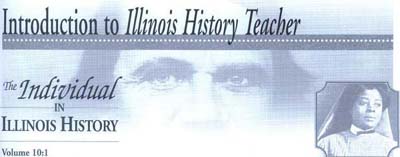 |
Home | Search | Browse | About IPO | Staff | Links |
 |
Home | Search | Browse | About IPO | Staff | Links |
|

History would be unimaginable without individuals. Historians first started looking at the past through the eyes and footsteps of individual people, almost always "the great men." In today's circumstances of religious and cultural turmoil we are reminded of the important role individual peacemakers and warriors can play in our lives. Increasingly through the twentieth century historians became aware of the important contribution individuals make daily in sustaining the systems—economic, political, social, and cultural—in which we are all active participants. This issue of the Illinois History Teacher examines individuals of both kinds, the heroic figure who seems to direct history's flow and the stalwart citizen who contributes in small ways. Stephen A. Douglas is surely one of Illinois' legendary leaders. In his day, Douglas's grand pretensions and his small physical stature earned him the nickname "The Little Giant." His leadership in the formulation of the Democratic party, not only in Illinois but nationally, and the introduction of the Illinois Central Railroad made lasting impressions on the young Prairie State, but they are seldom recalled today. Graham Peck brings to light one aspect of Douglas's career, his difficult maneuverings through the slavery issue in pursuit of advantages for the northern wing of the Democratic party. Teachers of the Civil War's background will find their own challenge made easier by using Bill Ulmer's curriculum materials in connection with Peck's narrative section. The volume next turns to Eva Monroe, who conducted social work for orphaned African American children in the early twentieth century. Her welfare focused exclusively on the state capital, Springfield, but it had overtones of the Progressive era in which she lived. Wanda Hendricks's narrative and Elaine Qadeem's curriculum material reveal much about a specific case and place, and readers may also be challenged to consider who, if anyone, did similar work in his town or city. Even if no such figure emerges, students can surely appreciate the critical role of the dedicated individual willing to step forth and do a thing for its own good sake. What good deed in any location can ever be mistaken for small work? Jane Addams on the other hand is a great woman more widely known than Monroe, yet Addams performed work in turn-of-the-twentieth-century Chicago roughly similar to Monroe's. Chicago historian Melvin Holli capably outlines Addams's work with the city's immigrants at a time of considerable social and ethnic turmoil, and Bruce Janu's curriculum materials provide a reliable entrance into Addams's life and times. The Illinois History Teacher published an article several years ago that partly dealt with Addams. We promise to return to her again on these pages as the opportunity arises. A study of James Henry Magee occupies the final pages of this volume. Magee's work embraced both the benevolent and the political. His mission was benevolent, like Monroe's and Addams's, but like Douglas his mode was often political. Another figure of local importance, Magee's life is long overdue for attention in classrooms. Roger Bridges shared his research on Magee in the narrative accompanying Gloria Pate-Hayes's equally good curriculum materials. In addition to thanking the authors who patiently answered questions as they honed their manuscripts in response to reviewers' recommendations, I acknowledge Thomas Schwartz, Kathryn Harris, and Bryon Andreasen, all of the Illinois Historic Preservation Agency. They either supplied information about the individuals in this volume, searched out illustrations for it, or identified authors who were recruited to write the volume. We all hope you enjoy using it for your classes in Illinois history.
Sincerely, 1 |
|
|